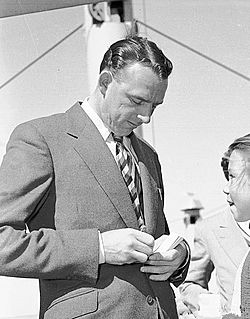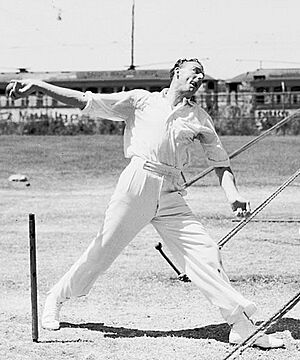Bob Appleyard facts for kids

Appleyard signing an autograph in 1954
|
||||||||||||||||||||||||||||||||||||||||
| Personal information | ||||||||||||||||||||||||||||||||||||||||
|---|---|---|---|---|---|---|---|---|---|---|---|---|---|---|---|---|---|---|---|---|---|---|---|---|---|---|---|---|---|---|---|---|---|---|---|---|---|---|---|---|
| Full name |
Robert Appleyard
|
|||||||||||||||||||||||||||||||||||||||
| Born | 27 June 1924 Bradford, West Riding of Yorkshire, England |
|||||||||||||||||||||||||||||||||||||||
| Died | 17 March 2015 (aged 90) Harrogate, North Yorkshire, England |
|||||||||||||||||||||||||||||||||||||||
| Batting | Right-handed | |||||||||||||||||||||||||||||||||||||||
| Bowling | Off-break, Right-arm fast-medium | |||||||||||||||||||||||||||||||||||||||
| International information | ||||||||||||||||||||||||||||||||||||||||
| National side | ||||||||||||||||||||||||||||||||||||||||
| Test debut | 1 July 1954 v Pakistan | |||||||||||||||||||||||||||||||||||||||
| Last Test | 7 June 1956 v Australia | |||||||||||||||||||||||||||||||||||||||
| Career statistics | ||||||||||||||||||||||||||||||||||||||||
|
||||||||||||||||||||||||||||||||||||||||
|
Source: CricInfo, 4 April 2018
|
||||||||||||||||||||||||||||||||||||||||
Bob Appleyard (born June 27, 1924, died March 17, 2015) was a famous English cricketer. He played for both Yorkshire and the England national team. Bob was known as one of England's best bowlers in the 1950s. This was a time when England had a very strong bowling attack.
Bob was a very versatile bowler. He could bowl both fast and with spin, using a similar action. This made him tricky for batsmen. Sadly, injuries and illness almost ended his career early. Even though he played in only a few Test matches, he took a wicket very often. In all first-class games, he took 708 wickets, showing how good he was.
Contents
Bob Appleyard's Cricket Journey
When Bob was young, he got very sick with a lung disease called tuberculosis. He had to stay in the hospital for almost a year. Even in the hospital, he kept his cricket skills sharp. He would squeeze a cricket ball under his bed covers to keep his fingers strong. He also had to learn to walk again and had part of his left lung removed.
After playing well in local games, Bob joined the Yorkshire team in 1950 when he was 26. He played three games for them. In two of these games, he took six wickets. In 1951, many thought Yorkshire would not do well. But Bob's amazing bowling helped them stay near the top. He took 200 wickets that season. This was the first time someone had done that in four years. His wickets in 1951 cost only 14 runs each.
Bob could bowl both fast and as a spinner. He did this without changing his bowling action much. This meant he could bowl for a long time without much rest. He was good in all weather and pitch conditions. Because of his great performance, he was chosen as a Wisden Cricketer of the Year.
Overcoming Illness and Test Cricket
After playing just one match in 1952, Bob became very ill again. He could not play cricket for the rest of 1952 and all of 1953. Many people thought he would never play again. But he made a surprising recovery in 1954. He quickly became one of the top bowlers.
He played his first Test match at Trent Bridge. He bowled very skillfully on a perfect pitch. In the first part of the game, he took 5 wickets. Because of this, Bob was chosen for the Ashes tour to Australia. He bowled well on the tricky Australian pitches. He was especially good in the heat of the Fourth Test in Adelaide. England won that game and the Ashes series.
Bob also played a key role in New Zealand. In March, his bowling helped New Zealand get out for a very low score. On a pitch affected by rain, he took 4 wickets for only 7 runs. New Zealand was bowled out for just 26 runs. This was the lowest score in Test cricket history at the time.
Later Career and Retirement
In 1955, Bob mostly bowled spin. He was almost impossible to hit on the wet pitches early that summer. But a knee injury stopped him from playing most of the cricket after June. He recovered well in 1956. He got his Test spot back for the first match at Trent Bridge. However, he did not bowl well enough to keep his place.
In 1957, Bob's performance started to decline. Yorkshire often left him out of the team. He struggled to show his old versatility. His decline continued in 1958. Yorkshire dropped him for good in early June. He never played well enough for the second team to be kept on.
Life After Cricket
After he stopped playing cricket, Bob Appleyard became a successful businessman. He also started a cricket school in his hometown of Bradford. He worked with the Sir Leonard Hutton Foundation Scheme. This scheme helped young cricketers. Bob raised over a million pounds for youth cricket. He even donated the money from his biography to this fund.
Bob was also known for standing up for himself. He worked for a company that was taken over by Robert Maxwell. Bob quickly realized that Maxwell was not honest. When Maxwell fired him, Bob fought for a fair payment. He won his case and wisely took his money out of the company's pension fund.
Personal Life
Bob Appleyard faced a very difficult time when he was young. He found his father, stepmother, and two younger sisters had died at home. This happened during World War II. His father had been very troubled by the war. Bob said it was hard to remember the details.
In 1997, the University of Bradford gave him an honorary doctorate. This is a special award. He served as the President of Yorkshire County Cricket Club from 2006 to 2008. He was also an Honorary Life Member of the club. Bob Appleyard passed away at his home in Harrogate on March 17, 2015, at the age of 90.
Images for kids




